Sights and Activities
Below are the places we saw and activities completed while visiting the India:
Varanasi
Ganges River: The city is regarded as one of Hinduism’s seven holy cities because of the river. The river is full of ghats, long stretches of steps leading down to the water, that people go to bathe, wash clothes, do yoga, offer blessings, play cricket, wash their buffaloes, cremate their loved ones, or simply hang out. We got to experience all this life around the river by both walking along the ghats and taking a boat ride. During our sunset boat ride, we saw cremations and a ganga aarti ceremony with puja (river worship ceremony with offerings) at Dasaswamedh Ghat.
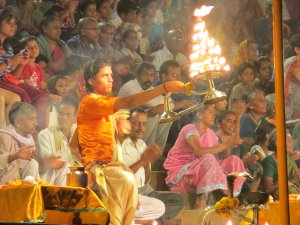
Vishwanath Temple: The temple was built in 1776 with 800 kg of gold plating. Non-Hindus are not allowed inside, but we were able to see the gold tower and dome.
Khajuraho
Temples: the Khajuraho temples are known as the “kamasutra” temples for their erotic sculptures. The details are very impressive and show the level of great skill and patience artists had over 1,000 years ago. Some of the notable temples include: Chaturbhuja Temple, Duladeo Temple, Parsvanath Temple, Adinath, Shanti Nath, Lakshmana Temple, Kandariya Mahadev Temple, Devi Jagadamba Temple, Chitragupta Temple, and Vishvanath Temple.
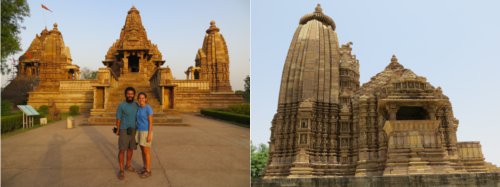
Bundeli Folk Dance: we were entertained by traditional Indian folk dancing

Bundeli Folk Dance
Agra
Taj Mahal: to some this World Heritage Site is the most beautiful building in the world and it really does not disappoint. It definitely goes high on our list of structures. The story behind the memorial is also interesting, it was built as a tomb by Shah Jahan, an emperor, for his third wife, Mumtaz Mahal, after her death in 1631. The complex was completed in 1653 and both Mumtaz and Shah are buried there. Some 20,000 people worked on the building and brought in as far as Europe to produce the exquisite marble screens and marble inlay work made with thousands semiprecious stones.
Agra Fort: the construction of this massive red, sandstone fort begun in 1565 and provides great views of the Taj Mahal.
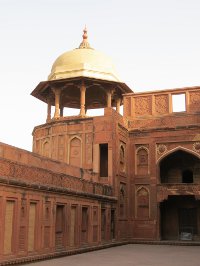
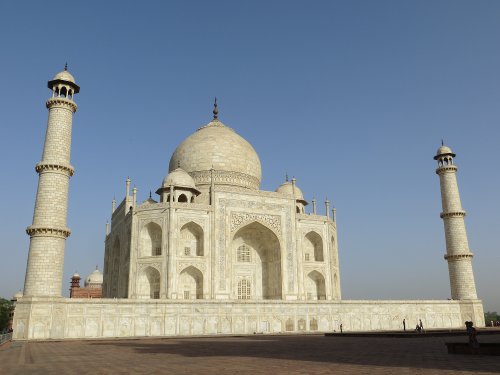
Jaipur
Hawa Mahal: constructed in 1799 this five-story pink, sandstone building provided us with great views of the city.
Janta Mantar: a 1728 observatory with bizarre sculptures used as instruments to study astrology.
Nagargarh Fort: on a hill about 8 km north of the city, we went to see stunning city and sunset views.
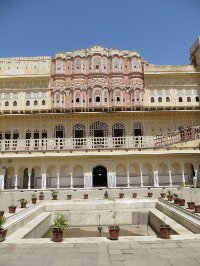

Amber Fort: this picturesque fort is more of a palace built from pale yellow and pink sandstone, and white marble.
City Palace: a complex of courtyards, gardens, and buildings with Rajasthani and Mughal architecture.

Delhi
Gandhi Smriti: site where Mahatma Gandhi was shot on January 30, 1948. Concrete footsteps represent Gandhi’s final steps that lead to a memorial pavilion known as Martyr’s Column. The site’s museum was where he was staying as a guest the last 144 days and contains photographs, paintings, quotes, and dioramas depicting scenes from his life.
Red Fort: constructed by Shah Jahan between 1638 and 1648. We saw 2 museums inside the fort: Indians Struggle for Freedom and the Archaeological Museum.

Humayun’s Tomb: this tomb, built in the mid-16 century, is a great example of early Mughal architecture. It brought Persian style to Delhi, but the combination of red sandstone and white marble is entirely local, showing the complementary merging of the different cultures. It was the inspiration of the Taj Mahal.
Amritsar
Jallianwalw Bagh: in 1919, this park was a scene of a peaceful demonstration with over 5,000 Indians in attendance against the British when without warning British forces opened fire killing and wounding many. There are several memorials of the martyrs that were massacred including a wall where bullet holes are still visible and an eternal flame of remembrance.

Mata Temple: a temple where women wishing to become pregnant go to pray. It contains an entertaining labyrinth that passes through ankle-deep waterways, low tunnels, staircases, walkways, and caves before reaching the main shrine.
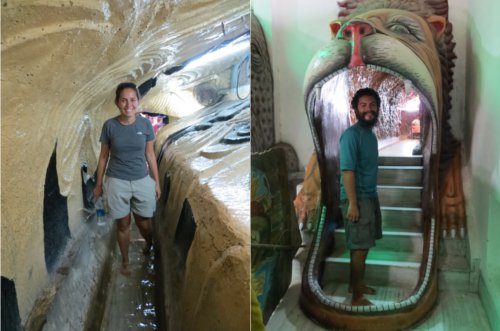
Sri Durgiana Temple: this temple surrounded by a holy water tank is a Hindu version of the Golden Temple.
Golden Temple: this is the Sikh’s holiest shrine and in their inclusive nature, everyone is welcome. You are required to wash your feet and cover your head before entering. The temple’s architecture is a blend of Hindu and Islamic styles. The golden dome represents an inverted lotus flower, a symbol of Sikh devotees’ aim to live a pure life. Taking a seat to view around or walking around the holy water tank gives a sense of peacefulness.


Mangalatha
We had a great opportunity to WWOOF at the Binsar Valley River Camp in a small village in the Uttrakhand province. We were able to learn about native fruits and vegetables, cook local cuisine, and take part in a vision of an extraordinary man. Be sure to read more about our experience in our article.
Udaipur
City Palace and Palace Museum: a large palace towering over the city with great views of Lake Pichola and Lake Palace Hotel in Jagniwas Island. The majority of the palace is the Palace Museum which contains many artefacts.
Jagdish Temple: hindu temple built by Maharana Jagat Singh in 1651.


Bagore-ki-Haveli: This gracious haveli, private mansion, contains 138 rooms set around courtyards and his home to the world’s biggest turban. There is also an art gallery, featuring contemporary and folk art.
Ajanta Caves
We took a day exploring this World Heritage Site that dates from around the 2nd century BC to the 6th century AD and later abandoned and forgotten until 1819, when a British hunting party stumbled upon them purely by chance. All 30 of these amazing caves were hand carved into a steep rock gorge along a river and painted with Buddhist mythical stories. At their peak, the caves were used as monasteries.

Mumbai
Chhatrapati Shivaji Terminus (Victoria Terminus): this is a gothic building that serves as one of Mumbai’s busiest train station
Elephanta Island: we took a ferry to visit this island located in the middle of the Mumbai harbor. The island is home to the Elephanta Caves, hand cut temples that are listed in the UNESCO World Heritage Sites. The temples are thought to have been created between AD 450 and 750.
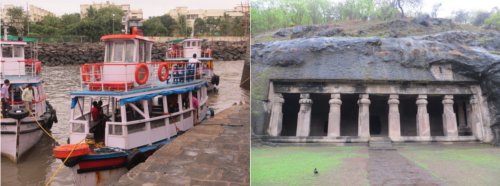
Taj Mahal Palace: we got a good view of this hotel from the ferry to Elephanta Island. It was built in 1903 by a Parsi industrialist, JN Tata, supposedly after he was refused entry to one of the European hotels for being ‘a native’.
Gateway of India: we also viewed this arch from the ferry to Elephanta Island. It was built to commemorate the 1911 royal visit of King George V.
Jehangir Art Gallery: featured modern art by local artists.

University of Mumbai and the High Court: the European influence is obvious as we viewed these gothic structures from the exterior.
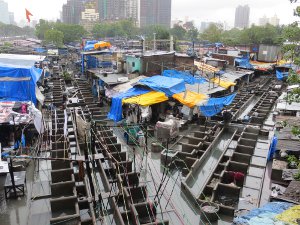
National Gallery of Modern Art: this museum showcased the art and life of Rabindranath Tagore, a big Indian icon.
Haji Ali’s Mosque: we were able to see this mosque from the shore, it has the appearance of an island during high tide when the ocean covers the access bridge.
Mahalaxmi Dhobi Ghat: this is a 140-year-old dhobi ghat, place where clothes get washed. The biggest human-powered washing machine!
Palolem
Palolem Beach and walked to Patnem Beach: we were in southern India during the monsoon season, rainy season, but were able to enjoy a few days relaxing near the beaches of the province of Goa. This area is known for their beach shacks during the high season, unfortunately by the time we arrived they were all taken down. We were able enjoy a nice hike from Palolem Beach to Patnem Beach.
Cabo da Rama Fort: this fort offered spectacular views of the ocean.
Agonda Beach: we spent a couple hours enjoying this nice sand beach.
Kochi
Chinese Fishing Nets: these interesting cantilevered contraptions are still used even though modern fishing techniques are making this labor intensive method less profitable. They have been in use since the early 15th century and takes a minimum of four people to operate them.
St Francis Church: it is believed to be India’s oldest European built church.
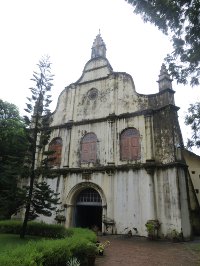
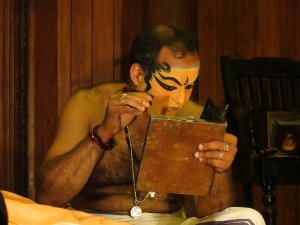
Kerala Kathakali Center: we enjoyed a traditional Kerala dance-drama show known as Kathakali. The performances are known for the make-up of the characters, costumes, face gestures, and body movements all in sync with percussion music and singing. The performers go through six years of education and practice before getting on stage.
Kathakali Eye Movement
Kathakali Performance
Kerala’s Backwaters: we took a tour on boat through the waterways and mangroves of Kerala, known as backwaters. Before roads existed, these waters were the only way to travel and now many villagers still use their hand paddled boats as their main form of transport. Our boat cruised along while being paddled by two men equipped with bamboo sticks that reached the bottom of the waters to be able to maneuver. We made a stop to see a factory where seashells were grinded, heated, and mixed with water to created calcium hydroxide. The next was a stop to see how the village people used the coconut fiber to create rope by twirling it together. We also had a traditional Keralan lunch served on banana leaves.

Santa Cruz Basilica: this basilica was originally built in 1506, but the current building dates to 1902.
Mattancherry Palace: also known as the Dutch Palace because they renovated it in 1663. The walls of the palace are filled with preserved Hindu murals and they also have a collection of hand carried carriages.
Pardesi Synagogue: we took a quick view of this synagogue that was built in 1568, then partially destroyed by the Portuguese in 1662, and rebuilt two years later when the Dutch took Kochi.
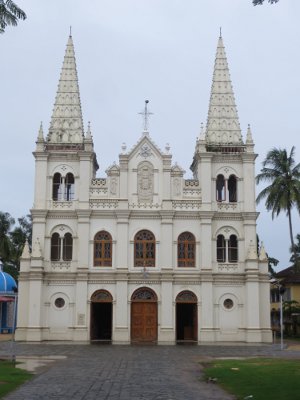
Train Travel
We spent 131 hours traveling by train across the country! This included nine overnight trips and many varying landscapes and ecosystems. We had some of the best conversations and experiences on the trains: from international tourists to locals, the people on the trains came in all types and interests.
